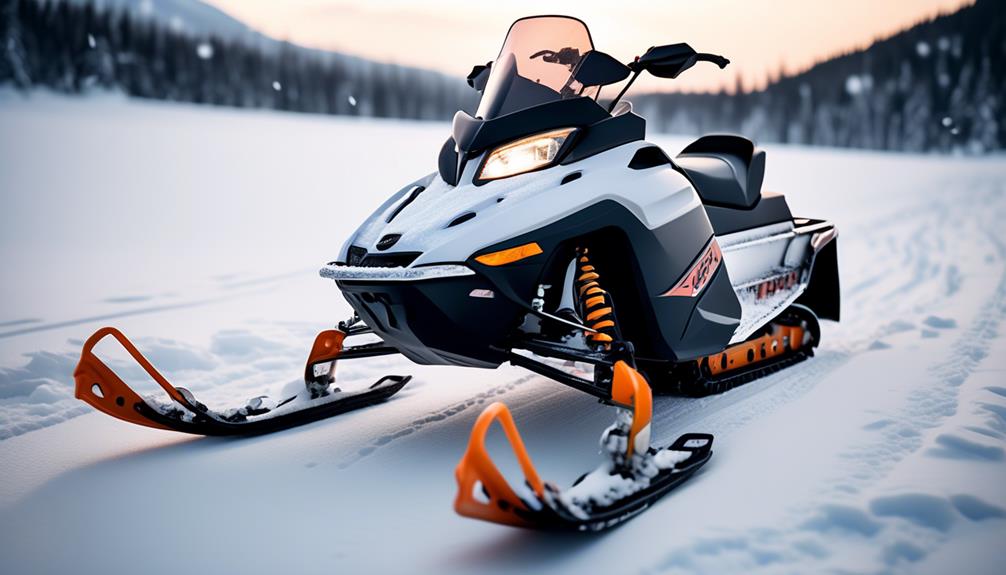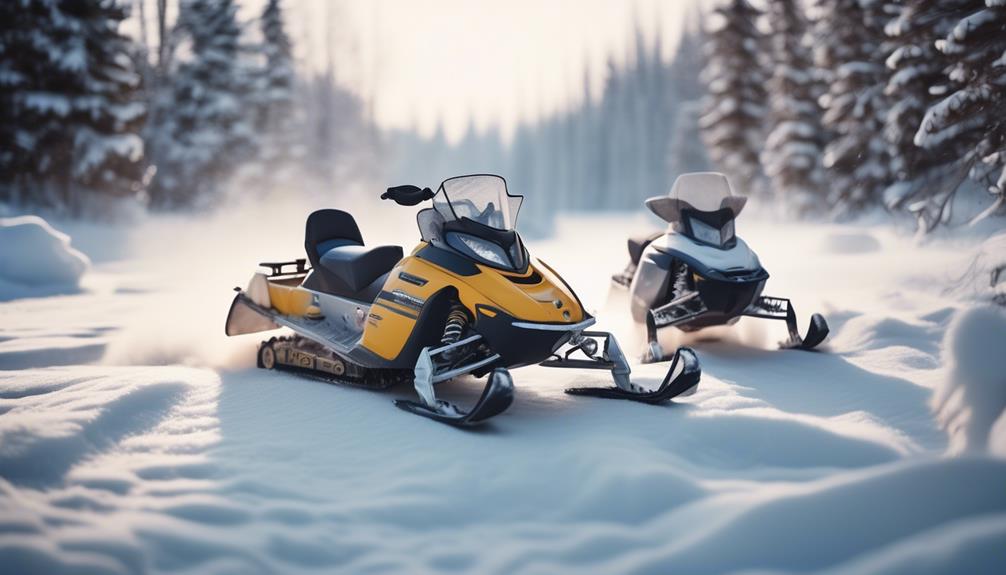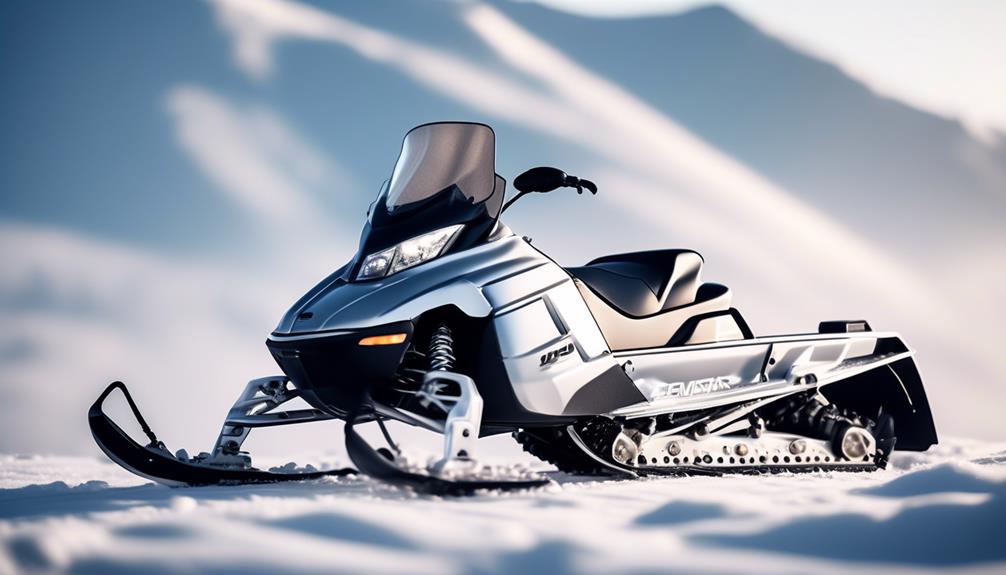When it comes to snowmobiling, enthusiasts often find themselves wondering about the weight of these vehicles. Understanding the weight of a snowmobile is not only important for transportation purposes but also for maneuverability and overall performance. In this discussion, we will explore the standard weight of snowmobiles, the factors that can affect their weight, and the options available for both lightweight and heavy-duty models. Furthermore, we will delve into the differences in weight between two-stroke and four-stroke engines, as well as provide some tips for effectively handling heavier snowmobiles. So, whether you're a seasoned snowmobiler or just curious about these winter machines, let's uncover the fascinating world of snowmobile weights.
Key Takeaways
- The average weight of a snowmobile is between 400 to 600 pounds (181 to 272 kilograms).
- Factors such as weight distribution, construction materials, and engine size/type influence the weight of a snowmobile.
- Lightweight snowmobiles offer benefits like improved acceleration, maneuverability, and fuel efficiency.
- Proper weight distribution, chassis design, and suspension systems play a significant role in snowmobile performance and handling.
Standard Snowmobile Weight

The standard weight of a snowmobile is an essential factor to consider when evaluating its performance and suitability for different terrains and activities. The average snowmobile weight varies depending on the make and model, but it typically falls between 400 to 600 pounds (181 to 272 kilograms). This weight range is considered optimal for providing a balance between stability and maneuverability on snow-covered surfaces.
Weight distribution on snowmobiles plays a crucial role in their overall performance. Manufacturers design snowmobiles with a specific weight distribution to ensure optimal handling and control. The weight is typically distributed towards the front of the snowmobile to improve steering response and reduce the chances of the rear end fishtailing.
The weight distribution also affects the snowmobile's ability to navigate various terrains. For example, a snowmobile with a more evenly distributed weight is better suited for deep powder snow conditions as it helps the machine float on top of the snow. On the other hand, a snowmobile with a front-heavy weight distribution is more suitable for hard-packed trails, providing better traction and stability.
It is important to note that the weight of a snowmobile can vary depending on additional features and modifications. Accessories such as cargo racks, heated grips, or larger fuel tanks can add extra weight to the snowmobile, affecting its performance and handling. Therefore, when considering the weight of a snowmobile, it is essential to take into account any added features or modifications to ensure an accurate evaluation of its suitability for specific activities or terrains.
Average Weight of Snowmobile Models
When considering the average weight of snowmobile models, it is important to examine the popular snowmobile weights and the factors that contribute to the overall weight of these vehicles. Snowmobile models vary in weight based on factors such as engine size, suspension system, chassis materials, and additional features. By understanding the average weight ranges and the factors influencing snowmobile weight, enthusiasts can make informed decisions when selecting a snowmobile model that suits their needs and preferences.
Popular Snowmobile Weights
Snowmobile weights vary significantly across different models, with each snowmobile's weight being a crucial factor in its performance and handling capabilities. When it comes to popular snowmobile weights, there are several brands and models that stand out. Here are some examples:
- Lightweight snowmobile brands: Companies like Ski-Doo and Arctic Cat are known for manufacturing lightweight snowmobiles. These brands focus on using advanced materials and innovative design techniques to reduce the overall weight of their machines, improving maneuverability and fuel efficiency.
- Weight distribution in snowmobiles: Proper weight distribution is essential for maintaining stability and control. Snowmobile manufacturers carefully design their models to ensure an optimal balance between the front and rear ends. This helps to improve traction, cornering, and overall handling on various terrain conditions.
- Model-specific weights: Specific snowmobile models, such as the Ski-Doo MXZ X-RS, Yamaha Sidewinder, and Polaris Indy, have different weight specifications. These models can range from around 450 lbs to 600 lbs, depending on factors like engine size, chassis design, and additional features.
Understanding the weight distribution and average weights of popular snowmobile models can help enthusiasts make informed decisions when purchasing a snowmobile that suits their needs and preferences.
Factors Affecting Snowmobile Weight
With snowmobile weights varying significantly across different models, it is important to understand the factors that affect the average weight of snowmobile models. Several factors contribute to the overall weight of a snowmobile. One of the primary factors is the engine size and type. Snowmobiles with larger and more powerful engines tend to be heavier. Another factor is the construction materials used. Snowmobiles made with lightweight materials such as aluminum or carbon fiber are generally lighter than those made with steel or other heavy materials. Additionally, the length and width of the snowmobile can also impact its weight. Longer and wider snowmobiles usually weigh more due to the increased surface area. Understanding these factors can help consumers choose lightweight snowmobile options that suit their needs.
Factors Affecting Snowmobile Weight

The weight of a snowmobile is influenced by a variety of factors. Understanding these factors is crucial for those seeking lightweight options. Here are some key considerations:
- Engine Size: The size and power of the engine significantly impact the weight of a snowmobile. Larger engines tend to be heavier, while smaller engines offer lighter options. It is important to find the right balance between engine power and weight based on your specific needs and preferences.
- Chassis Design: The design and construction of the snowmobile's chassis also play a significant role in determining its weight. Manufacturers use different materials, such as aluminum or lightweight composites, to reduce the overall weight of the chassis without compromising strength and durability.
- Accessories and Features: The inclusion of various accessories and features can add extra weight to a snowmobile. Some common examples include cargo racks, heated seats, and advanced navigation systems. When considering a snowmobile's weight, it is essential to evaluate whether these additional features are necessary for your intended use.
Lightweight Snowmobile Options
When it comes to snowmobiles, weight plays a crucial role in determining performance. Lightweight snowmobiles offer several benefits, including improved acceleration, maneuverability, and fuel efficiency. Choosing the right model that strikes a balance between weight and power is essential for riders seeking optimal performance on the snow.
Weight and Performance
Lightweight snowmobile options are vital for optimizing performance and maneuverability in various snow conditions. When it comes to weight and performance, two key factors to consider are weight distribution and weight reduction techniques. Here are three lightweight snowmobile options that can enhance your riding experience:
- Carbon fiber construction: Snowmobiles built with carbon fiber frames and components offer significant weight reduction while maintaining strength and durability.
- Advanced suspension systems: Utilizing lightweight materials and innovative designs, these suspension systems help to reduce overall weight and improve handling on rough terrains.
- High-performance engines: Snowmobiles equipped with lightweight, high-output engines provide a power-to-weight ratio advantage, allowing for better acceleration and speed.
Benefits of Lightness
Optimizing performance and maneuverability in various snow conditions requires considering the benefits of lightness, which can be achieved through lightweight snowmobile options. A lightweight design offers several advantages, including increased fuel efficiency and improved handling on snowy terrains.
By reducing the overall weight of the snowmobile, it becomes easier to navigate through deep snow and tight corners. This enhanced maneuverability allows riders to have better control and responsiveness, resulting in a safer and more enjoyable experience.
Moreover, lightweight snowmobiles are more fuel-efficient. With less weight to propel, the engine doesn't have to work as hard, leading to reduced fuel consumption. This not only saves money but also minimizes the environmental impact by reducing carbon emissions.
To highlight the benefits of lightweight snowmobile options, here's a table showcasing some popular models and their weights:
| Snowmobile Model | Weight (lbs) | Fuel Efficiency (MPG) |
|---|---|---|
| Yamaha Sidewinder | 618 | 15.7 |
| Ski-Doo MXZ X-RS | 434 | 18.5 |
| Polaris Indy XC 600 | 475 | 17.2 |
| Arctic Cat ZR 6000 | 486 | 16.8 |
| Honda Talon X | 893 | N/A |
These lightweight snowmobile options demonstrate the correlation between weight and fuel efficiency, allowing riders to make informed choices based on their priorities.
Choosing the Right Model
To select the most suitable lightweight snowmobile model, careful consideration must be given to factors such as performance, terrain, and personal preferences. When choosing the right size, it is important to consider the intended use of the snowmobile. Smaller models are typically more maneuverable and easier to handle, making them ideal for those who enjoy navigating through tight trails. On the other hand, larger snowmobiles offer increased stability and better weight distribution, making them a better choice for off-trail riding and deep snow conditions. Weight distribution plays a crucial role in snowmobile handling. Models with a balanced weight distribution provide better control and agility, allowing riders to confidently tackle various terrains. Ultimately, selecting the right lightweight snowmobile involves finding the perfect combination of size, weight distribution, and handling to suit individual preferences and riding style.
Heavy-Duty Snowmobiles for Extreme Conditions
With the demand for snowmobiles capable of withstanding extreme conditions on the rise, manufacturers have responded by designing heavy-duty models that deliver unparalleled performance and durability. These heavy-duty snowmobiles are specifically engineered to tackle the harshest weather conditions, ensuring that riders can safely navigate through deep snow, icy terrains, and other challenging environments.
When it comes to heavy-duty snowmobiles, manufacturers prioritize strength and resilience. These models are built with reinforced frames and chassis, allowing them to withstand the immense pressure and stress of navigating through extreme weather conditions. Additionally, they feature enhanced suspension systems, which provide superior stability and control, even on rough and uneven terrain.
To further enhance their performance in extreme weather conditions, heavy-duty snowmobiles are equipped with powerful engines. These engines are specially designed to deliver high torque and power, ensuring that the snowmobile can effortlessly glide through deep snow and overcome obstacles.
Moreover, heavy-duty snowmobiles come equipped with advanced track systems. These tracks are wider and have deeper lugs, providing optimal traction on slippery surfaces. This allows riders to maintain control and stability, even in the most challenging conditions.
Safety is also a significant consideration in the design of heavy-duty snowmobiles. Manufacturers incorporate features such as advanced braking systems, improved visibility through LED lights, and ergonomic designs for rider comfort. These features help ensure that riders can navigate through extreme weather conditions with confidence and peace of mind.
Differences in Weight Between Two-Stroke and Four-Stroke Engines

Given the emphasis on performance and durability in heavy-duty snowmobiles designed to withstand extreme conditions, it is important to explore the differences in weight between two-stroke and four-stroke engines. The weight of an engine plays a crucial role in the overall performance and handling of a snowmobile, impacting factors such as fuel efficiency, handling, and maneuverability.
Here are some key differences in weight between two-stroke and four-stroke engines:
- Two-Stroke Engines:
- Two-stroke engines are typically lighter than their four-stroke counterparts. This is because they have a simpler design with fewer moving parts, resulting in a reduced overall weight.
- The lightweight nature of two-stroke engines allows for improved maneuverability and agility, making them ideal for riders who prioritize speed and quick turns.
- However, it is worth noting that the lighter weight of two-stroke engines can sometimes result in a less stable ride, especially in rough or uneven terrains.
- Four-Stroke Engines:
- Four-stroke engines are generally heavier than two-stroke engines due to their more complex design and additional components, such as valves and camshafts.
- The increased weight of four-stroke engines can provide better stability and control, especially at higher speeds or when traversing challenging terrains.
- Additionally, the added weight of a four-stroke engine may contribute to better fuel efficiency, as these engines tend to consume fuel more efficiently compared to their two-stroke counterparts.
Tips for Maneuvering Heavy Snowmobiles
Snowmobile riders can enhance their maneuvering skills when handling heavy snowmobiles by implementing a few key tips. Maneuvering a heavy snowmobile requires careful attention to weight distribution and the use of proper techniques. By following these tips, riders can improve their control and handling, ensuring a safe and enjoyable ride.
One important technique for maneuvering heavy snowmobiles is to maintain a balanced weight distribution. This involves keeping your body centered and your weight evenly distributed between the skis. By doing so, you can maintain stability and prevent the snowmobile from tipping over. Additionally, keeping your weight centered allows for better control and responsiveness when turning or changing direction.
Another important maneuvering technique is to use your body to help steer the snowmobile. By leaning into turns, you can shift the weight distribution and initiate a smoother turn. Leaning forward can also improve traction and help the snowmobile maintain its momentum in deep snow or on uneven terrain.
Furthermore, proper throttle control is crucial when maneuvering heavy snowmobiles. Gradually applying and releasing throttle, rather than abruptly accelerating or decelerating, allows for smoother and more controlled movements. This helps to prevent the snowmobile from jerking or skidding, ensuring a safer and more comfortable ride.
Lastly, practicing and familiarizing yourself with the specific handling characteristics of your snowmobile is essential for maneuvering heavy machines. Each snowmobile model may have different weight distribution and handling characteristics. By spending time getting to know your snowmobile, you can better anticipate its responses and adjust your techniques accordingly.
Frequently Asked Questions
How Much Does a Snowmobile Cost?
The cost of a snowmobile can vary depending on various factors such as the brand, model, features, and condition of the vehicle. Snowmobile prices typically range from a few thousand dollars for entry-level models to tens of thousands of dollars for high-performance or specialized models. Additionally, factors such as location, dealer pricing, and seasonal demand can also impact the cost. It is advisable to research and compare prices from different sources to find the best deal within your budget.
What Are the Different Types of Snowmobiles Available in the Market?
When considering the different types of snowmobiles available in the market, it is important to take into account the various snowmobile brands and engine types. Popular snowmobile brands include Arctic Cat, Ski-Doo, Polaris, and Yamaha, each offering their own unique features and performance capabilities. Engine types commonly found in snowmobiles are two-stroke and four-stroke engines, with each offering different advantages in terms of power, efficiency, and environmental impact. Understanding these factors can help individuals make an informed decision when choosing a snowmobile that best suits their needs.
Are There Any Safety Regulations or Requirements for Using a Snowmobile?
Safety regulations and requirements for using a snowmobile vary depending on the jurisdiction. These regulations typically cover aspects such as age restrictions, licensing or certification requirements, mandatory safety equipment, and guidelines for operating the vehicle in specific areas. It is crucial for snowmobile operators to familiarize themselves with local laws and regulations to ensure their safety and the safety of others. Compliance with these regulations helps minimize the risk of accidents and promotes responsible use of snowmobiles.
What Are the Fuel Efficiency Ratings for Different Snowmobile Models?
Snowmobile fuel consumption and its environmental impact are important factors to consider when choosing a snowmobile model. Various snowmobile models have different fuel efficiency ratings, which can be influenced by factors such as engine size, weight, and design. It is advisable to consult the manufacturer's specifications to determine the specific fuel efficiency rating for a particular model. Considering fuel consumption and its impact on the environment is crucial for those seeking to minimize their carbon footprint and reduce their overall environmental impact while enjoying snowmobiling.
Can Snowmobiles Be Used for Any Other Purposes Apart From Recreational Activities?
Snowmobiles have applications beyond recreational activities. They can be used for transportation in areas with heavy snowfall or difficult terrain. Their agility and ability to traverse snowy surfaces make them useful for search and rescue operations, allowing teams to access remote areas quickly. Snowmobiles are equipped with features such as cargo racks and towing capabilities, making them suitable for carrying supplies or equipment. These versatile vehicles serve as valuable tools in serving others by providing efficient transportation and aiding in emergency situations.
Conclusion
In conclusion, the weight of a snowmobile can vary depending on various factors such as the model, engine type, and additional features. Standard snowmobiles typically weigh around 500 to 600 pounds, while lightweight options can weigh as little as 400 pounds. On the other hand, heavy-duty snowmobiles designed for extreme conditions can weigh up to 800 pounds or more. Understanding these weight variations can help riders choose the most suitable snowmobile for their needs. Through the exploration of snowmobile weight, we are reminded that even in the pursuit of adventure, every detail matters.

